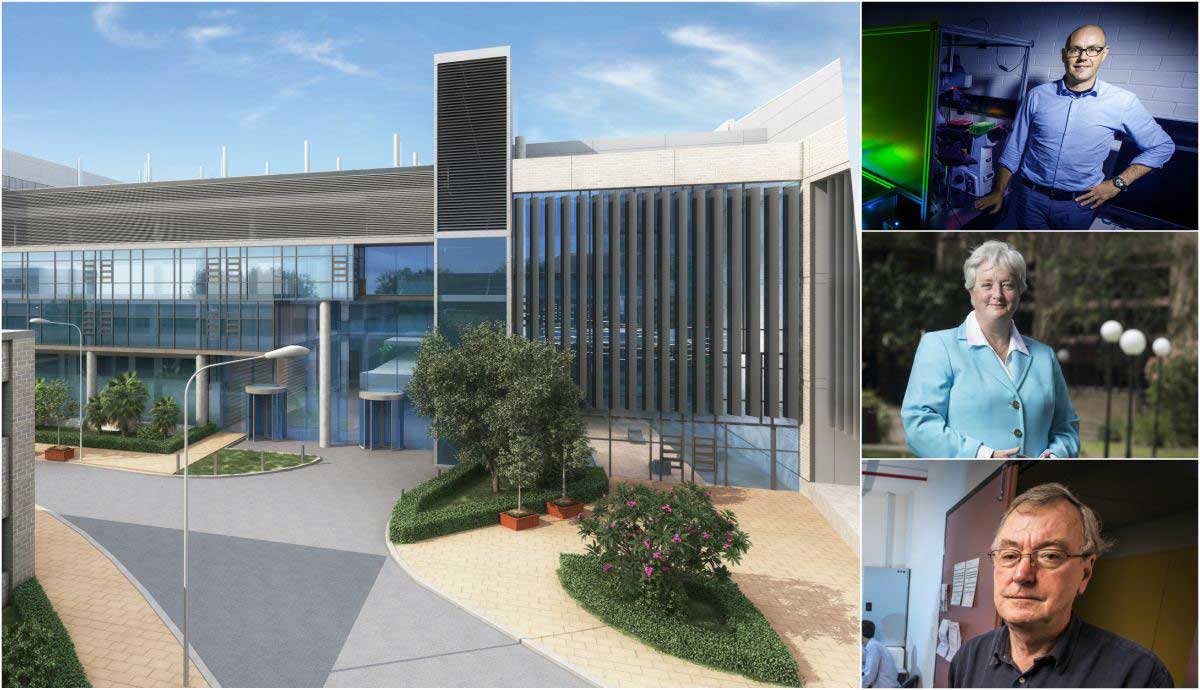October 18, 2016
World’s biggest health challenges to be confronted in Wollongong
UOW announces world-leading $80m molecular and life sciences research centre.
The city of Wollongong, south of Sydney, is set to become a hub of revolutionary medical research and discovery following the launch today (19 October 2016) of UOW’s plans for a world-leading research facility.
Molecular Horizons: the University of Wollongong’s $80 million Centre of Molecular and Life Sciences and its biggest ever self-funded research infrastructure investment, was launched at Parliament House in Canberra by Vice-Chancellor Professor Paul Wellings CBE and distinguished guests before a gathering of Australian political leaders, international dignitaries and prominent members of Australia’s medical and scientific community.
The purpose-built collaborative research centre will be equipped with world-leading technologies, centred around the revolutionary $7m Titan Krios cryo-electron microscope.
The three metre tall, one tonne Titan Krios microscope—one of only a handful in the world and only the second, but most advanced, in Australia— is the world’s most powerful and flexible high-resolution electron microscope for biological research.
It will allow researchers to see with unprecedented clarity the inner workings of human cells and enable new health-related breakthroughs.
UOW has also acquired a second microscope, the Talos Arctica, which is a smaller version of the same sophisticated imaging technology and complements the flagship Titan Krios with faster sample preparation.
It will be the first of its kind in Australia and be installed in an existing building to begin operating in the coming months and then be relocated into the new centre once built.
By generating three dimensional visualisations of protein molecules—the most structurally complex molecules inside human cells—the Titan Krios and Talos Arctica microscopes will allow researchers to understand how proteins move and interact over time.
This is critical to developing new ways to detect and fight diseases ranging from cancer to Alzheimer’s or developing new classes of antibiotics to fight superbugs.
Purpose designed to foster interdisciplinary collaboration, Molecular Horizons will be located alongside existing intellectual strongholds in the areas of physical sciences, biology and laser chemistry in the Illawarra Health and Medical Research Institute (IHMRI) and existing teaching and research facilities in the Faculty of Science, Medicine and Health to provide a seamless transition for students from learning to research.
It will house around 150 researchers, including prominent research teams led by internationally renowned Professors Nick Dixon, Antoine van Oijen and Mark Wilson, and be equipped with facilities from single-molecule to molecular and cellular imaging including X-ray crystallography, electron microscopy and flow cytometry as well as single-molecule and high-resolution fluorescence microscopy, structural mass spectrometry and nuclear magnetic resonance spectroscopy.
Approximately $25 million of the total $80 million project cost will be devoted to microscopes and associated lab equipment.
The establishment of Molecular Horizons is expected to foster increased collaboration with organisations such as Monash University in Melbourne (home of Australia’s only other Titan Krios microscope), the Victor Chang Cardiac Research Institute in Sydney and leading international institutions including Harvard Medical School and Johns Hopkins University in the USA.

A transformative investment
UOW Vice-Chancellor Professor Paul Wellings, CBE, described UOW’s self-funded investment in Molecular Horizons as an investment in the future health of all Australians and an example of how innovation can play a critical role in transforming regional communities.
“The Molecular Horizons facility will do something totally transformative for Australia: it will allow researchers here at the University of Wollongong along with our strategic partners, to do cutting-edge research and produce research outputs that will have a tremendous impact on people’s lives.
“By combining the very best equipment available with a truly interdisciplinary approach in a purpose designed collaborative research facility, UOW will be able to attract and retain some of the world’s best researchers and have research teams work together to make revolutionary health-related discoveries.
“Molecular Horizons will also allow the University and Australia to collaborate with the world’s best universities and research institutions on a whole new level,” Professor Wellings said.
Research partner collaboration
The Victor Chang Cardiac Research Institute in Sydney has a longstanding research collaboration relationship with UOW.
Professor Robert Graham AO, Executive Director of the Victor Chang Cardiac Research Institute has welcomed UOW’s investment in the centre.
“Molecular Horizons will place the University of Wollongong at the forefront of a field of science that is in the midst of a revolution and position it as a research hub for single-molecule and cell visualisation.
“The Victor Chang Cardiac Research Institute already has a very strong relationship with the University of Wollongong and the new Molecular Horizons will further promote collaborations between our two institutions.
“The investment by the University in such as critical piece of equipment in the Titan Krios microscope will be a great plus for the Victor Chang Institute, for the University and for the people of Australia.
“This rare, cutting edge technology will be in demand by researchers not only in NSW but also from other researchers in other states, and even internationally,” Professor Graham said.
UOW Health and Wellbeing Strategy
Molecular Horizons is also the centrepiece of UOW’s Health and Wellbeing Strategy, which includes a raft of initiatives aimed at harnessing UOW’s expertise in medical research, research application and education to address regional and global health challenges.
UOW Pro Vice-Chancellor (Health Strategy) and Executive Dean, Faculty of Science, Medicine and Health, Professor Alison Jones sees the University’s investment in Molecular Horizons as a key enabler for the future.
“We recognise the future of science is crucially dependent on understanding life at a molecular level. That’s why we are investing in leading-edge technology for the new science that is going to make a difference.
“Investing in the revolutionary technology is critical to giving our researchers and research partners the tools they need to make significant health-related breakthroughs.
"The technology at Molecular Horizons will enable us to move from developing treatments to finding cures,” Professor Jones said.
Construction of Molecular Horizons will commence in mid-2017 and the centre is expected to open in 2019.
